Last weekend I travelled with my long time foursome to visit Barton Creek in Austin, Texas. My research on this website yielded little information about the courses at the resort, of which there are four. I did not take too many pictures on this trip. I was too busy enjoying good company, trying to digest giant ribs and trying to win $2 bets to focus on my photography skills.
As to the resort, it is a very enjoyable place to stay with nice rooms and good service. Barton Creek adheres to the strategy of getting customers in the door with a low rate off season and then soaking the customers on premise. Food and beverage is incredibly expensive although the breakfast buffet included in the price was outstanding. Carts for replay rounds were priced at $30 per person and a cart is a necessity on all but the Crenshaw course unless one enjoys mountain climbing. We quickly learned to do our eating off site.
While none of the courses would make a listing of the top courses I have played they provide a nice opportunity for someone interested in golf course architecture to compare the two leading approaches to designing courses in recent decades: two Fazio courses and an early Coore/Crenshaw minimalist effort.
Fazio Foothills The Fazio courses are the most popular at the resort. The original course (Fazio Foothills) dates to 1987. It is a cartball course on severe terrain with some long drives between holes. It also probably sets a record for the most waterfalls on any course on earth. The course seemed very narrow to me, with the narrowness more pronounced by very firm ground and wind in the 10-15 mph range. The greens were pretty demanding on one’s iron game with plenty of creek beds and other severe hazards guarding the front of relatively small greens.
I was apparently too busy hitting duck hooks into the trees to take any pictures of the course but this link provides a course tour.
http://www.bartoncreek.com/fazio-foothills.aspx One thing Fazio seems to do well that I enjoy is to include short par threes. On this course three of the four par threes measure less than 150 yards from the tees we played. The course also has a terrific short par four of about 260 yards – slightly uphill. Off the tee it looks like a no brainer to try and drive the green but extremely severe bunkers and depressions short left of the green as well as a very large cliff hard against the back of the green create significant risk to those that attempt such an aggressive shot. I would need to play the hole a few times to form a solid opinion but in our group, four drives wound up on the perimeter of the green and the result was one par, one bogey and two doubles. Laying up would most likely resulted in an easy par.
I do not remember a lot of memorable holes on the course. The 18th is a memorable par five finish that winds uphill and has a cave guarding the aggressive 2nd (or 3rd shot).
One effect of these short holes is that the course plays a bit longer than the yardage on the card. We played it from the gold tees (a little over 6600 yards) and it seemed infinitely longer, even in warm weather.
Fazio Canyons The Canyons course is a few miles away from the main resort. I would guess the course post-dates the Foothills course. It provides more room off the tee than the Foothills course and is generally less demanding on iron play. It seemed to me that the greens were less severe, but because I played the course later in the trip and played it twice, my feel for putting in Hill Country may have improved significantly, rendering comparisons meaningless.
The course tour from the website:
http://www.bartoncreek.com/fazio-canyons.aspx(Some day, I would like to see course descriptions written without the marketing fluff. I cannot imagine all of that hyperbole actually helps to sell rounds.)
Several holes on the course were memorable. The par-five 7th was a strong three shot par five with a canyon crossing on the second before an iron to an uphill green. The hole ate my lunch twice but I would love another crack at it.
The par-four 10th featured a very difficult iron approach with a stream fronting the green as well as a cliff to the left. These features made a good tee shot critical on the down-hill dogleg right.
The 16th was my favorite hole on the course. Uphill and a little over 300 yards we played the hole downwind one day and my line was over the bunker left and the limestone wall on the right came into play. We played the hole into the wind the next day which made a short punch shot to a back pin with water left and an abyss behind the green a significant challenge. Here is the view from the tee:
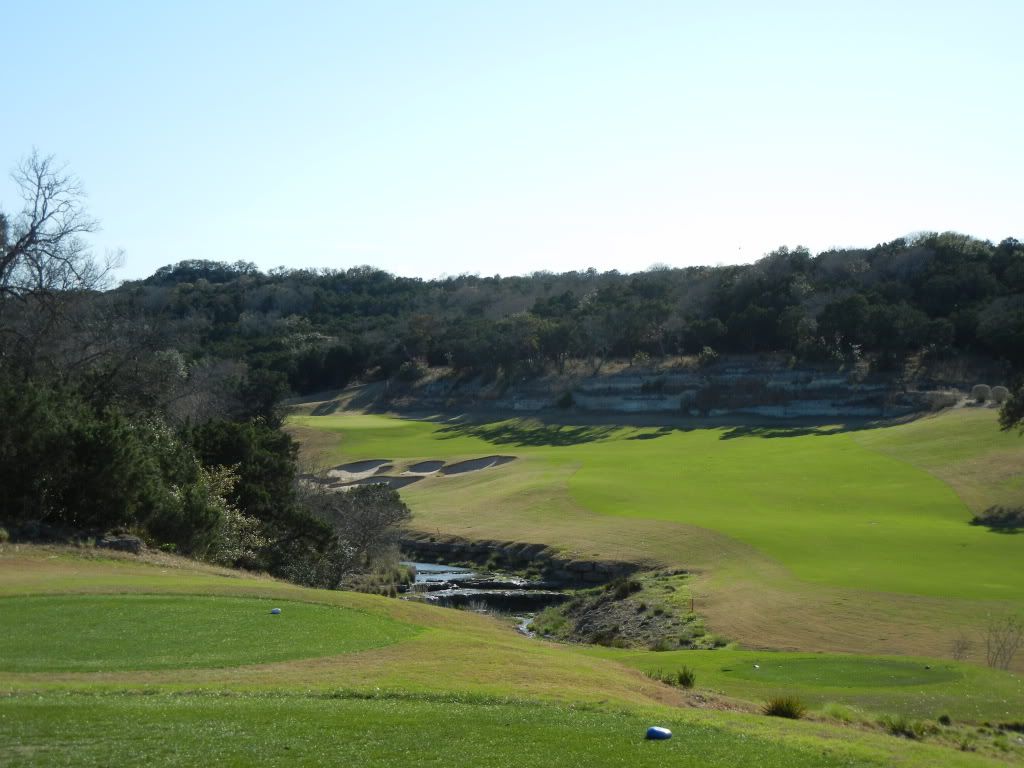 Palmer Lakeside
Palmer Lakeside The Palmer and Crenshaw courses at the resort are considered the lesser lights by paying customers. The Palmer course dates from 1986 and is about 35 miles away from the resort. Portions of the course sit atop high cliffs over Lake Travis. Despite 20-25 mph winds and very cold temperatures, I was pleasantly surprised by the course as it easily exceeded my very modest expectations.
Course tour: http://www.bartoncreek.com/palmer-lakeside.aspx
View from the first tee:

My favorite hole might have been the par five sixth. The hole was reachable in two for our group with two perfect shots, but a tree short left of the green made the choice of line for the second an interesting decision. This picture gives some sense of the second shot:
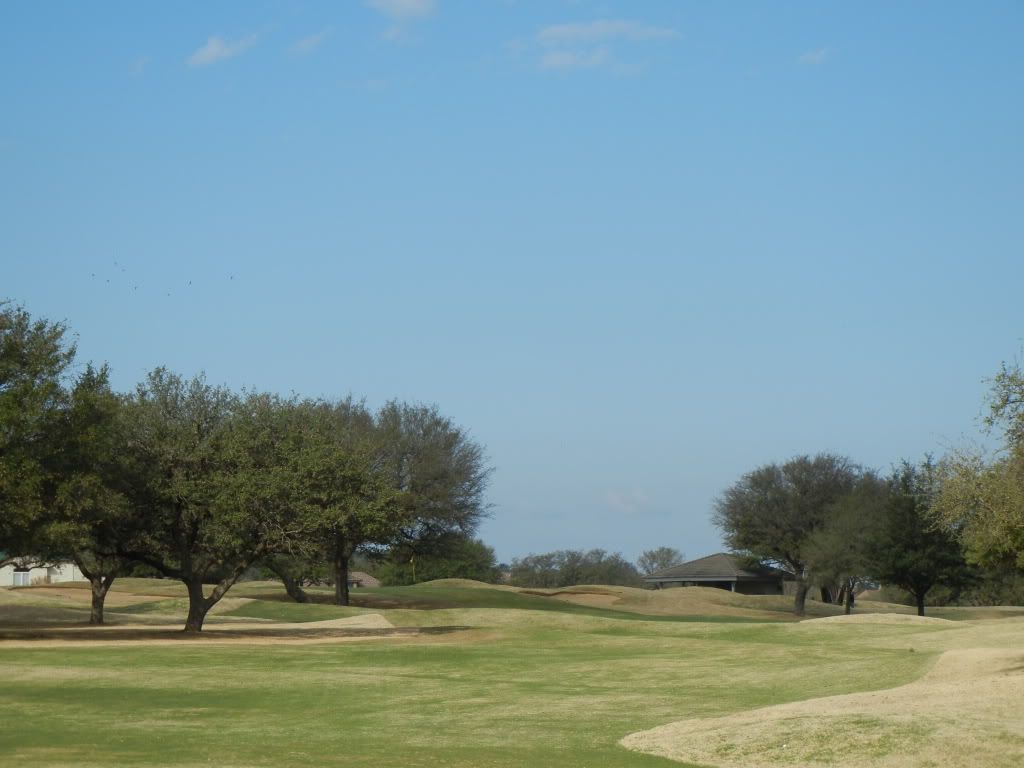
The most memorable hole on the course is the par three 14th. The hole is not so memorable for the shot – 120-140 yards to a reasonable sized green with modest contours. However, the setting is spectacular – perched on a very high cliff above Lake Travis:
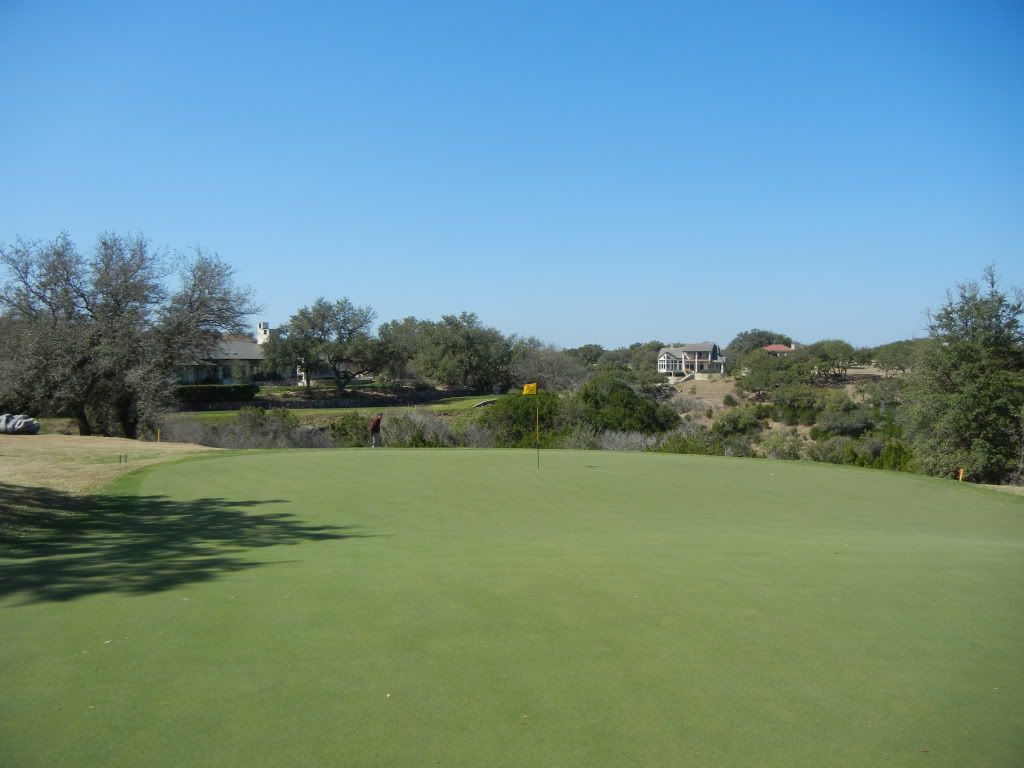
 Crenshaw Cliffside
Crenshaw Cliffside Course Tour:
http://www.bartoncreek.com/crenshaw-cliffside.aspx The Crenshaw Cliffside Course dates from 1991 and, along with the Plantation Course had the earliest opening of the Coore/Crenshaw design team. It therefore provides an interesting historical glimpse into the early approach of this duo. I have no idea how much dirt was moved to build this course – I suspect a fair amount given the severity of the terrain. Nonetheless, this course reflects the lay of the land philosophy for which they later became famous.
I would love to travel in a time machine back to 1991 and hear comments from customers who had a steady stream of these types of views throughout the round:
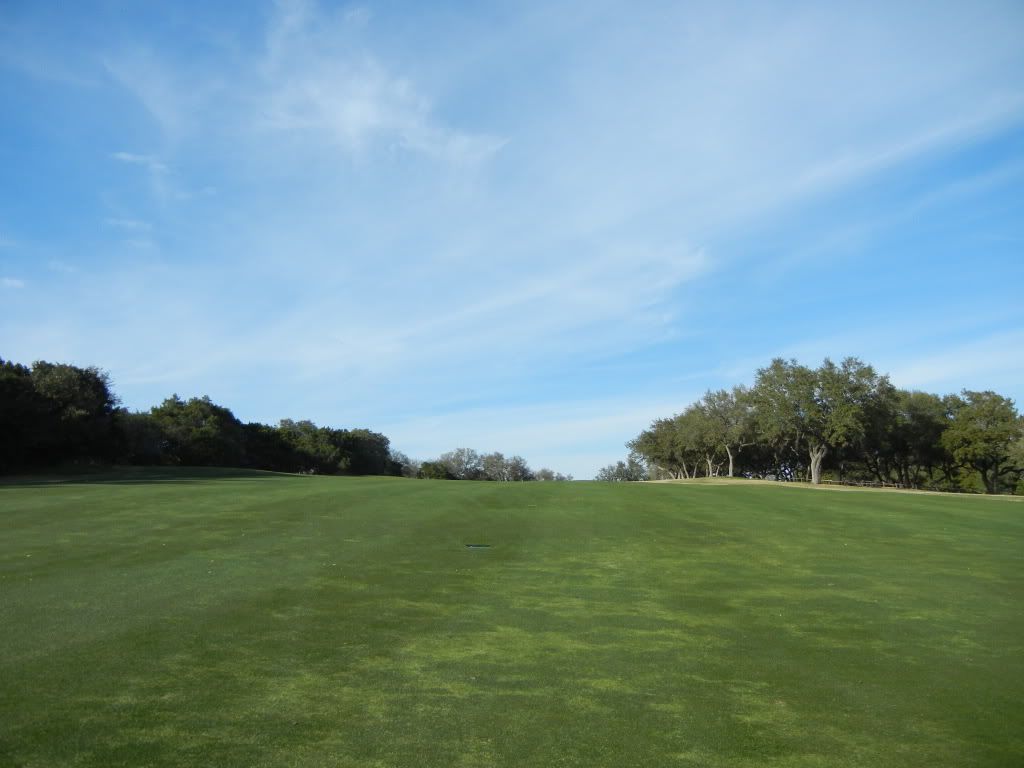
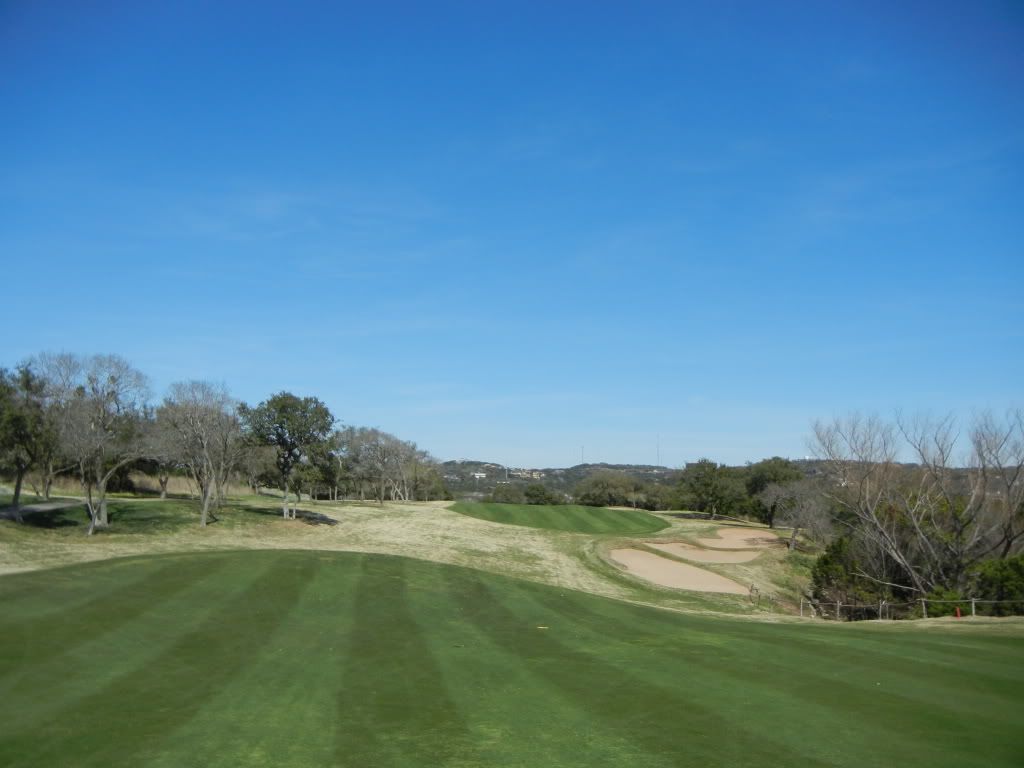
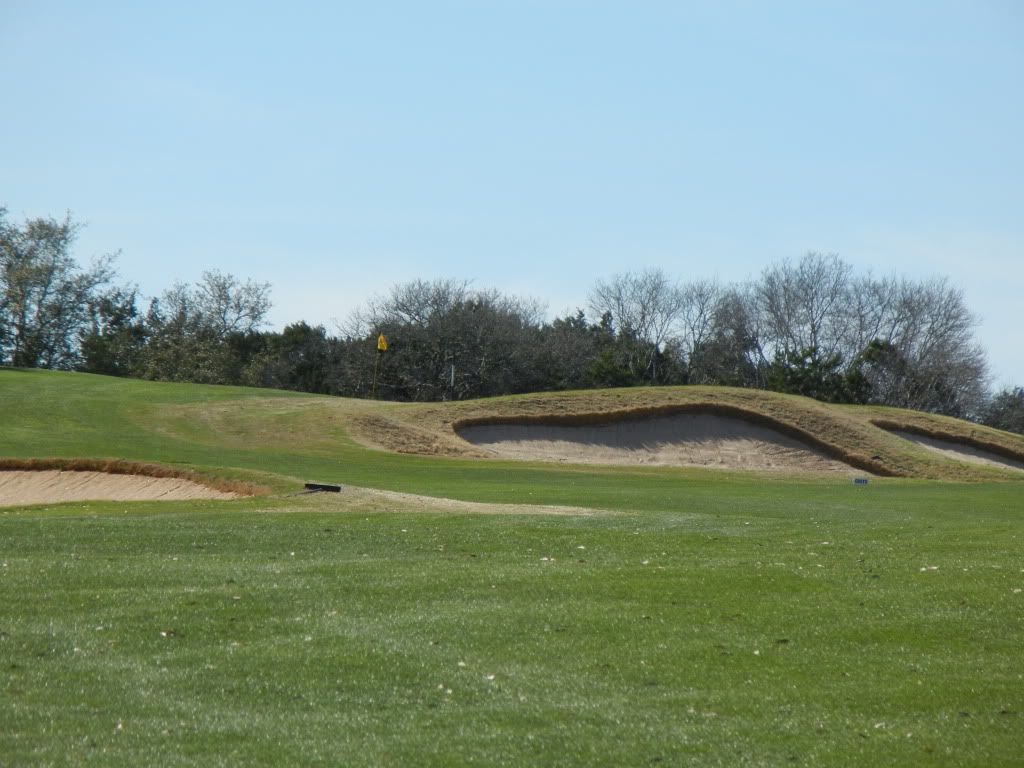
Another big advantage of the course is that it is walkable. My sense is that walkers are almost an endangered species in this region of the country. I saw several groups hoofing it around the course – something I would have done had I only been playing 18 holes a day.
Bill McBride claims that 13 of the 18 greens slope front to back and while I did not audit his calculation, I would guess he is correct. This side view of the 6th green (465 yard par four) demonstrates the type of challenge presented throughout the course.
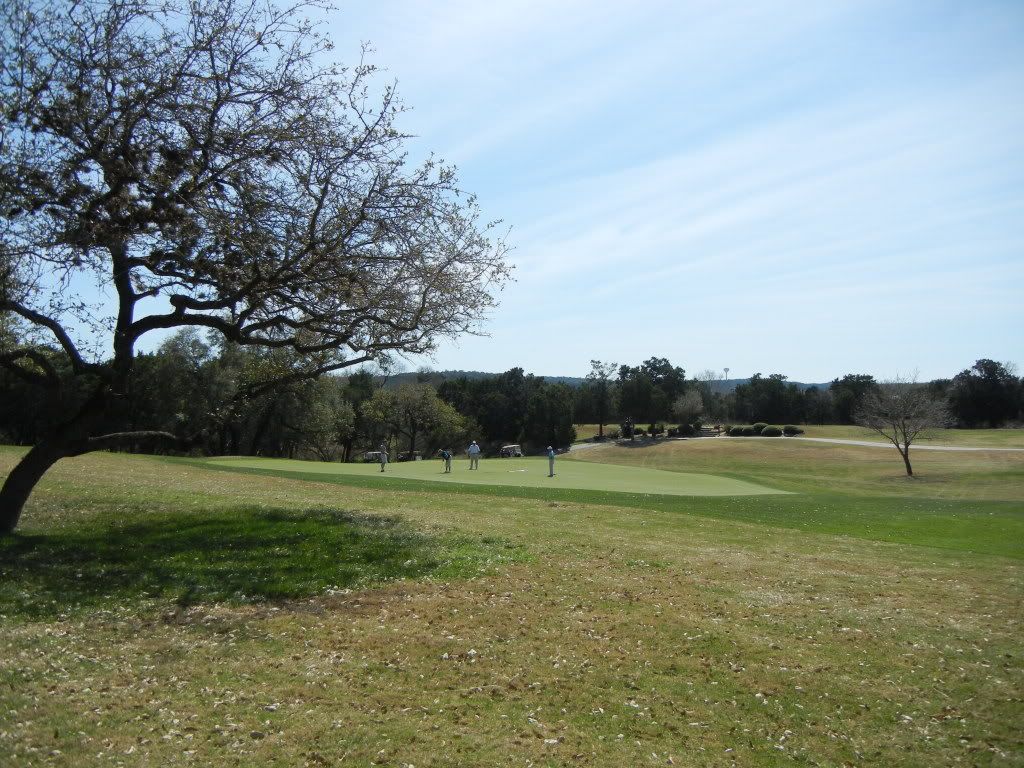
I really liked several of the individual holes on the course. One of my favorites was a redan-like par three 13th. 160 yards to a green with a wash in front and a cliff behind. The back left pin required that one hit the ball to the middle of the green and feed it left - a formidable task into the wind.

The course is by far the most hospitable to a wide range of playing abilities. Forced carries are generally short and nearly every green accepts a running approach. The course rating of 72.2 and a slope of 118 attests to a course that can be enjoyed by all.
There are drawbacks to this type of course.
Most significantly – it is almost impossible to determine visually the best manner to attack the course. Blind shots exist all over the place, especially off the tee. The front to back and side to side slopes of the greens are not readily apparent to the player, and even if they are generally apparent, the degree to which a ball will run or bounce sideways is almost impossible to calculate for the first time visitor.
I think many customers would not find the tee to green portion of the course interesting. The fairways are wide and the advantage of a better angle is only learned from experience and cannot be learned by eyesight.
Coore/Crenshaw's reliance on long and short par fours leaves relatively little room for challenges in the middle. I find myself wishing for a simple driver/7 iron hole. Instead, the driver, the fairway woods and the wedge get a real workout.
Finally – the 17th green is extremely severe and reminded me of the 11th at Penard – with a very narrow green and a bank behind that allowed bank shots onto the green. The crucial difference is that the 17th at this course is fronted by a canyon and a bank shot can easily feed back into the hazard if the bounce is too strong.
Nonetheless, I preferred the Crenshaw course over the others by a pretty wide margin. The width was an enjoyable antidote to the Fazio courses. It was nice to have a poorly struck iron run along the ground rather than go in water. The putting and chipping around the greens was terrific fun and we learned as we went along. We played the course twice in one day and our group scored significantly better the second time around.